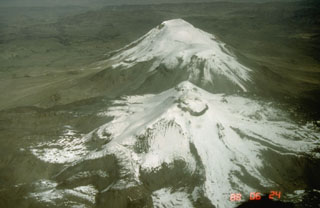Report on Sabancaya (Peru) — 18 December-24 December 2024
Smithsonian Institution / US Geological Survey
Weekly Volcanic Activity Report, 18 December-24 December 2024
Managing Editor: Sally Sennert.
Written by JoAnna G. Marlow.
Please cite this report as:
Global Volcanism Program, 2024. Report on Sabancaya (Peru) (Marlow, J G, and Sennert, S, eds.). Weekly Volcanic Activity Report, 18 December-24 December 2024. Smithsonian Institution and US Geological Survey.
Sabancaya
Peru
15.787°S, 71.857°W; summit elev. 5960 m
All times are local (unless otherwise noted)
The Centro Vulcanológico Nacional (CENVUL) of Instituto Geofísico del Perú (IGP) reported that moderate levels of eruptive activity continued at Sabancaya during 16-22 December. A daily average of six explosions were recorded, ejecting ash-and-gas emissions as high as 1.8 km above the summit. The emissions dispersed as far as 10 km to the W and NW. Seismicity included a total of 159 earthquakes associated with magma and gas movement, as well as earthquakes related to rock-fracturing processes inside or near the volcano. Slight inflation of the N sector of the volcano complex continued (near Nevado Hualca Hualca, located approximately 7 km N). Sulfur dioxide (SO2) emissions were classified as low, with an average of 632 tons per day. Additionally, a combined total of two thermal anomalies were detected in the area of the lava dome within the crater (with a maximum value of 1 MW). The Alert Level remained at Orange (the third level on a four-level scale) and the public was advised to stay at least 12 km away from the summit crater in all directions.
Geological Summary. Sabancaya, located in the saddle NE of Ampato and SE of Hualca Hualca volcanoes, is the youngest of these volcanic centers and the only one to have erupted in historical time. The oldest of the three, Nevado Hualca Hualca, is of probable late-Pliocene to early Pleistocene age. The name Sabancaya (meaning "tongue of fire" in the Quechua language) first appeared in records in 1595 CE, suggesting activity prior to that date. Holocene activity has consisted of Plinian eruptions followed by emission of voluminous andesitic and dacitic lava flows, which form an extensive apron around the volcano on all sides but the south. Records of observed eruptions date back to 1750 CE.

